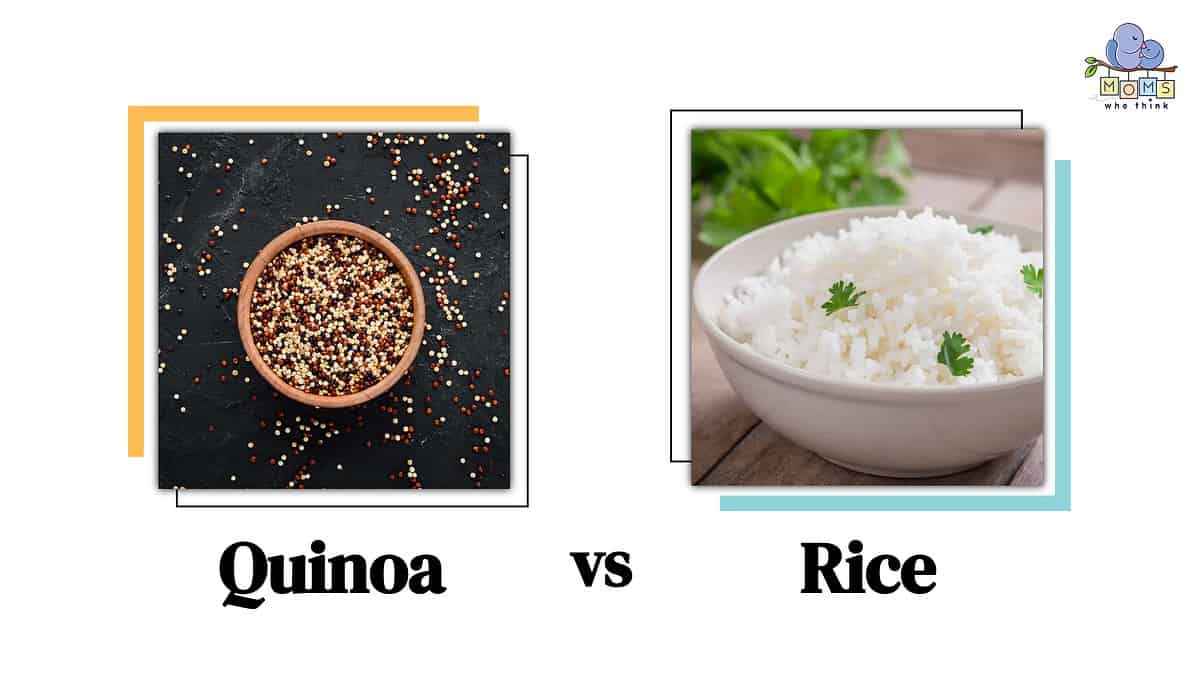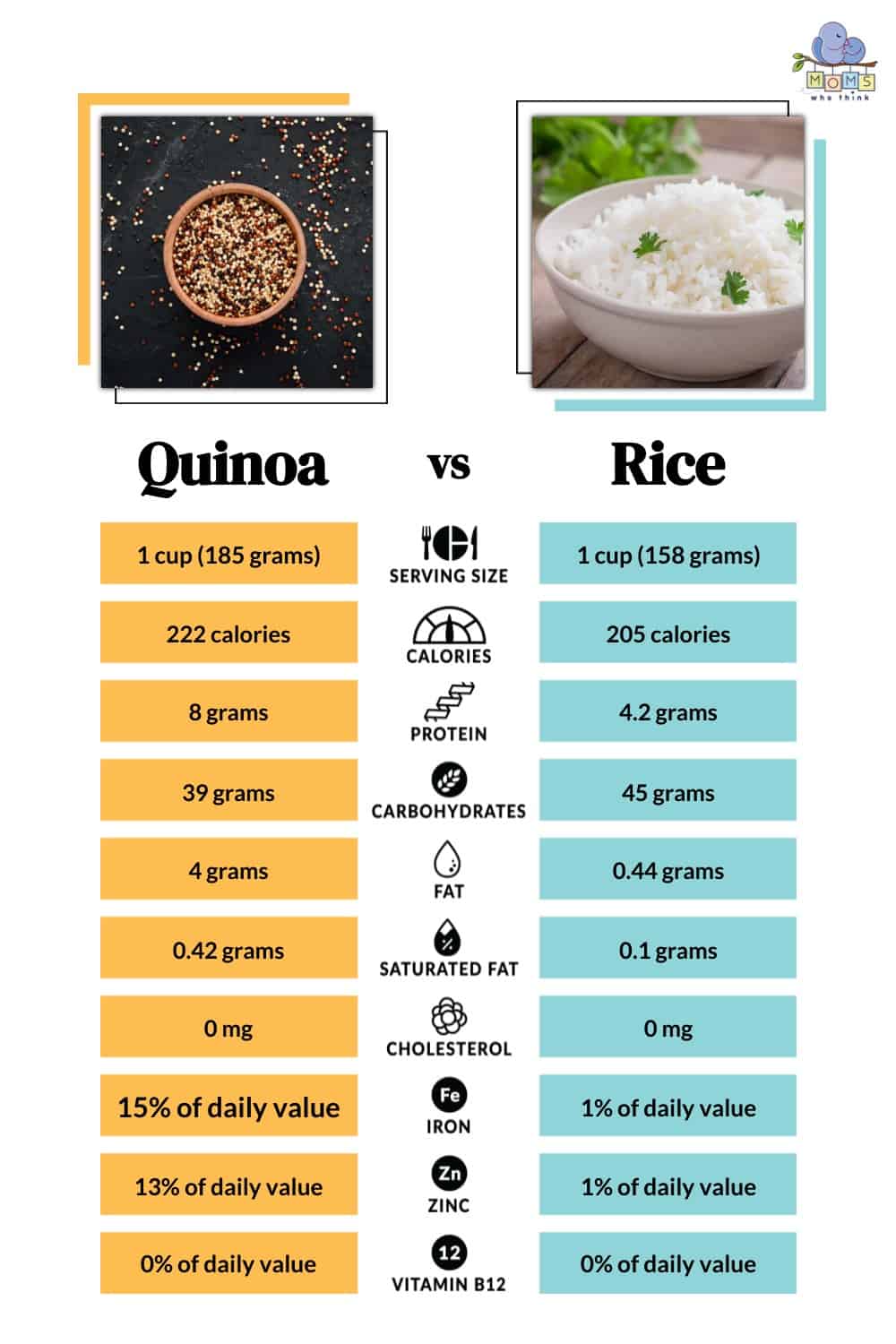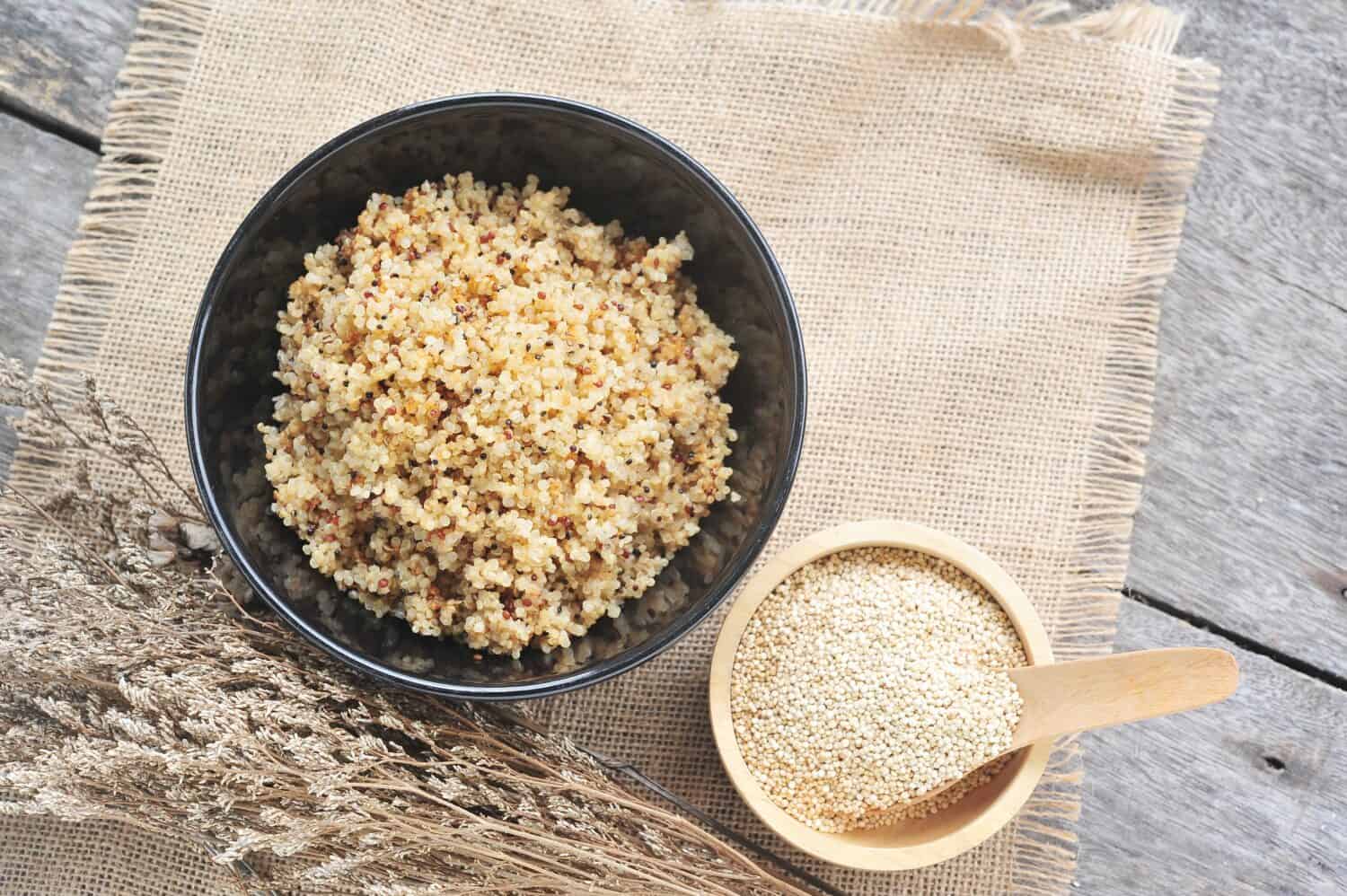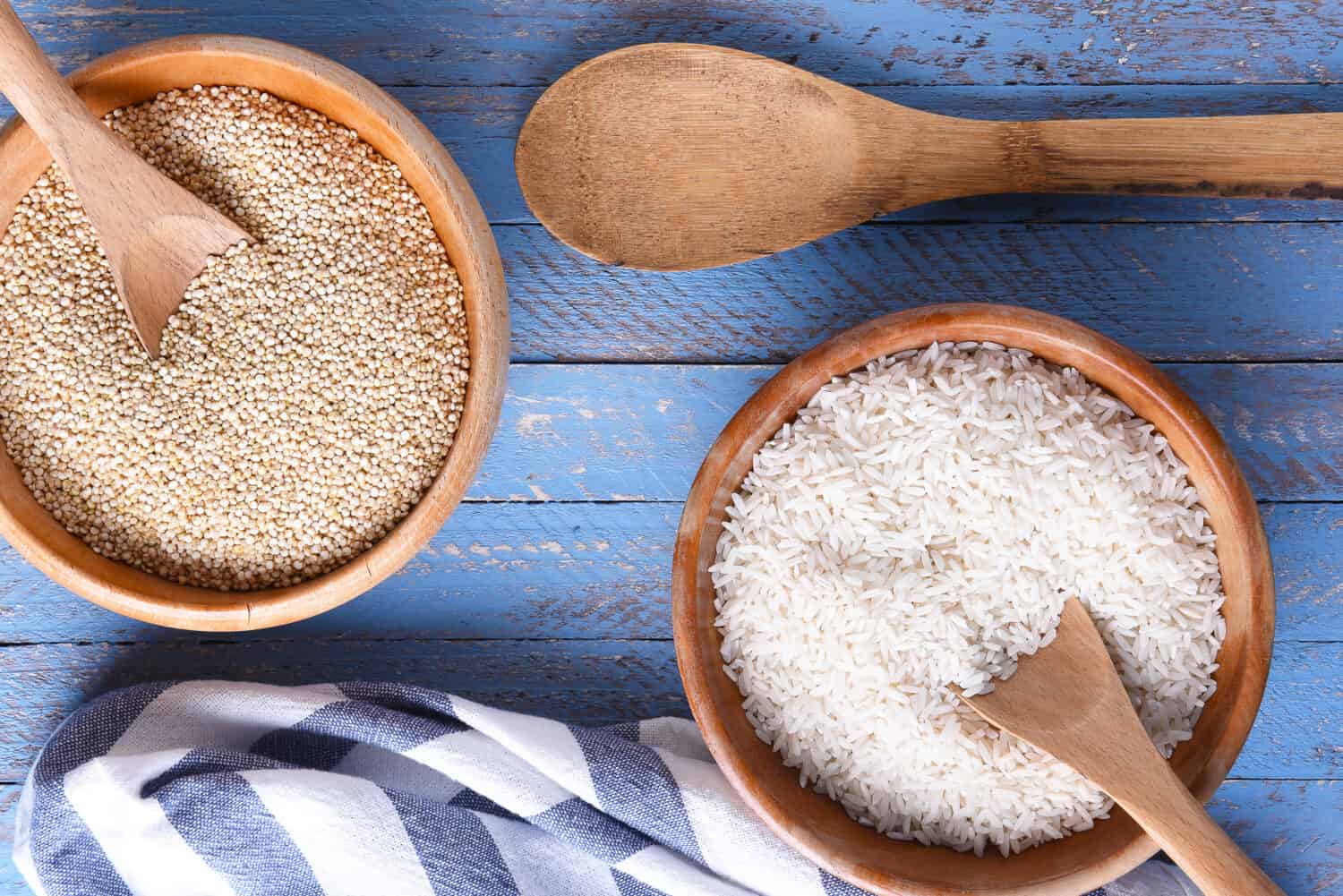While rice remains a popular food staple worldwide, quinoa (pronounced KEEN-wah) is growing in popularity. Often called a “superfood,” quinoa has a lot of protein (unusual in plant-based foods) and contains a significant amount of fiber and antioxidants. However, white rice also offers nutrients and vitamins. Moreover, rice is an excellent source of carbohydrates and low in fat.
Quinoa and rice are both nutritious grains, but quinoa's reputation is that it is the healthier option. Is that actually true? We will compare the health benefits of quinoa and rice and examine their nutritional values. Finally, we will determine which grain is the better health choice in the quinoa vs. rice debate.

Quinoa vs. Rice: What is quinoa?
Packed with fiber and protein, quinoa originated in South America. Until recently, it was relatively unknown but quickly rose in popularity after being touted as a superfood. Over 7000 years old, the Incas cultivated the plant and believed quinoa was a sacred grain. Its popularity spiked after the United Nations declared 2013 the “International Year of Quinoa.”
Quinoa looks and cooks like grain; technically, quinoa is a seed from the Chenopodium quinoa plant. There are over 120 varieties of quinoa, with the black, red, and white varieties being the most popular. While quinoa often looks like a fluffier version of couscous after cooking, the taste varies among the different types of quinoa.
While white quinoa is the fluffiest and mildest variety, red quinoa has a chewier texture and a heartier taste. This differs from black quinoa, which has an earthier flavor than the first two varieties. Quinoa even comes in colors like purple, orange, and pink. A tri-color black, red, and white blend can also be found in stores. However, the subtle flavor differences make quinoa an excellent choice for salads and food bowls. If substituting for rice in a recipe, white quinoa typically works best.
Quinoa vs. Rice: What is rice?
In addition to being one of the world's oldest grains, rice is a food staple for more than half of the Earth's population. An extremely versatile food, rice is boiled or ground into flour. People enjoy it as a main dish or a side dish. It also appears in soups, breakfast cereals, and alcoholic drinks like sake.
Rice originated in Asia but is now grown worldwide. However, China still produces ninety percent of the world's rice crop. Nowadays, rice has many varieties, including white and brown rice, basmati rice, jasmine rice, and wild rice. Each kind of rice has a different taste and texture, so for the purpose of this research, we will focus on white rice.
While brown rice is a whole grain, white rice goes through a milling process that removes the bran and germ. While brown rice is more nutritious because it retains the bran and germ, producers enrich white rice with many of the removed nutrients. White rice has a mild taste and cooks up fluffy and light. It is also cheap and has a long shelf life, making it an everyday kitchen staple.
Quinoa vs. Rice: Nutritional comparison
Quinoa and rice are nutritious, gluten-free grains but have some key differences, most notably in their protein content. Additionally, quinoa is a complete protein source, containing all nine essential amino acids, making it an excellent choice for vegetarians and vegans. In addition to the protein content, quinoa offers more fiber, typically five more grams than white rice.
While white rice has a high glycemic index, which can cause a spike in blood sugar, quinoa has a low glycemic index, making it an excellent choice for those watching their sugar intake.

Quinoa vs. Rice: Health benefits of quinoa
Quinoa is one of the healthiest foods you can eat. In addition to being a complete protein source and high-fiber food, quinoa contains heart-healthy monounsaturated fats. These fats reduce heart disease risk due to their ability to lower cholesterol levels.
Quinoa contains magnesium, phosphorus, and calcium, essential for maintaining strong bones. The anti-inflammatory compounds in quinoa may reduce chronic inflammation in the body, potentially lowering the risk of chronic diseases. Finally, high fiber and protein can make you feel full and aid in weight management.
Here are the four key health takeaways regarding quinoa.
- Quinoa is a superfood because it is rich in vitamins and minerals; it contains all nine essential amino acids, making it a complete protein source.
- A good source of fiber, quinoa aids digestion, helps regulate blood sugar levels, and can contribute to a feeling of fullness. Quinoa also supports a healthy gut.
- It is naturally low in saturated fat and cholesterol and contains heart-healthy monounsaturated and polyunsaturated fats. Additionally, the magnesium in quinoa can help regulate blood pressure and reduce the risk of heart disease.
- It is naturally gluten-free, making it an excellent option for people with celiac disease or gluten sensitivity. If you are gluten-free, quinoa is a versatile and nutritious grain substitute.
Quinoa vs. Rice: Health benefits of rice
While white rice has the reputation of being less nutritious than quinoa and brown rice, it does offer health benefits. It is rich in carbohydrates, providing a quick boost of energy. If you are worried about fat intake, white rice is naturally low in fat. Moreover, this gluten-free food is easy on the digestive system. Finally, while it may not make you feel as full as quinoa, white rice is a low-calorie food.
Here are the four key health benefits of rice.
- White rice is easy on the digestive system because it is milled and processed to remove the bran and germ layers. Removing these removes most of the fiber and some natural fats, thereby eliminating much of the nutritional value. However, it does make white rice suitable for individuals with digestive issues or sensitive stomachs.
- White rice has a lot of carbohydrates, which are the body's primary energy source. Eating white rice is beneficial for athletes or individuals with high energy requirements.
- Like quinoa, white rice is naturally gluten-free, making it a safe choice for people with celiac disease or gluten sensitivity. It is often used as a substitute for grains like wheat, barley, or rye in various dishes.
- White rice is naturally low in fat, particularly saturated fat. A low-fat diet aids heart health and weight management when combined with a balanced diet.
Quinoa vs. Rice: Which one is better for you?
Overall, it is clear that quinoa is the more nutritious option. While white rice is a good source of carbohydrates, quinoa has a well-rounded nutritional profile that white rice lacks. White rice doesn't have the bran and germ that provide the fiber and protein in quinoa. Therefore, quinoa may be better for those seeking more nutrients.
Unfortunately, white rice alone lacks essential nutrients and dietary fiber. Eating white rice in moderation or mixing it with other grains, vegetables, and protein sources improves its health benefits. Nevertheless, white rice can still be part of a balanced diet when eaten in moderation and combined with other nutrient-rich foods.

©Umpaporn/Shutterstock.com
In summary
Quinoa and white rice are both gluten-free foods that offer several health benefits. Quinoa stands out for its impressive protein content, which is rare in grains. It is also high in fiber while being rich in vitamins and minerals. Moreover, quinoa is an excellent choice for vegetarians, vegans, and those looking to add a nutrient-dense grain to their diet.
In contrast, white rice provides a quick energy source and is easy on the digestive system. Its versatility and low cost make it a staple in kitchens worldwide. Adding quinoa and white rice to your diet allows you to enjoy the benefits of these delicious, versatile foods.
The image featured at the top of this post is ©Steve Cukrov/Shutterstock.com.

